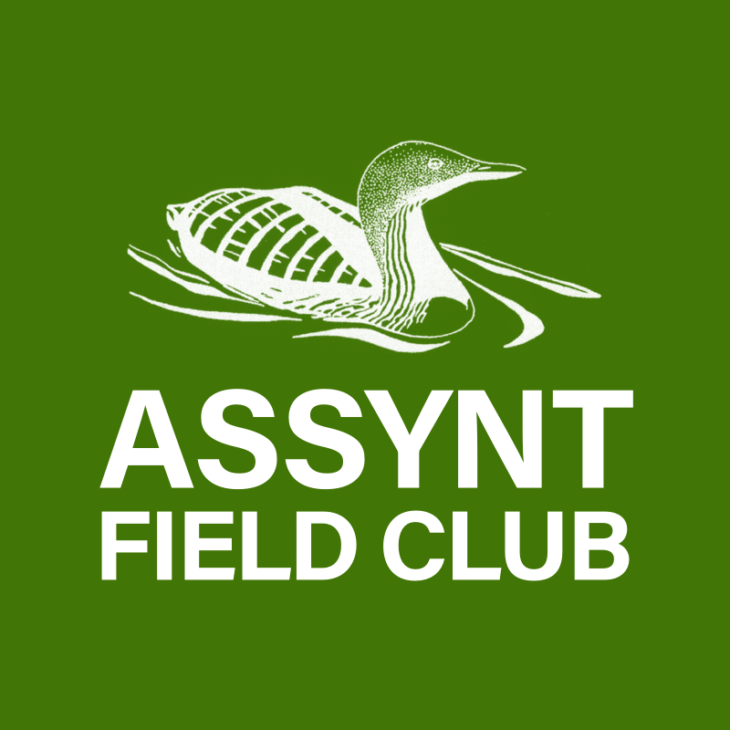What to Spot: September Edition
,
Welcome to our September Edition of What to Spot. Birds beginning to migrate south, trees beginning to turn golden and a slight chill in the air; Autumn is coming. There is still plenty to see out and about!
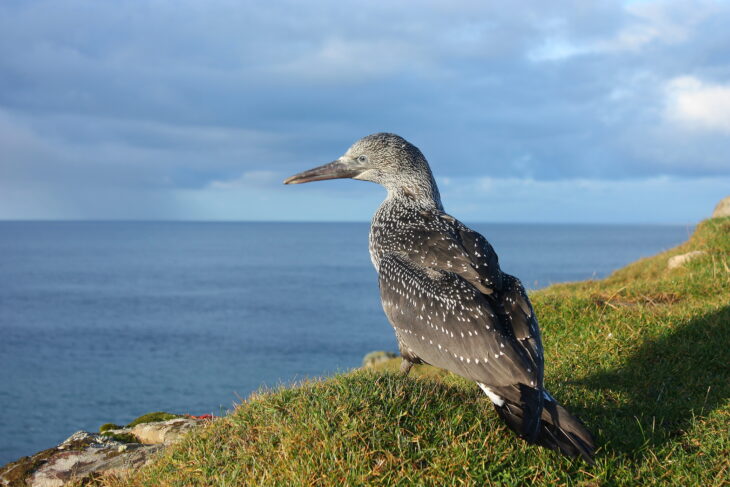
One of the largest birds we have within CALL is the beautiful Gannet (Morus bassanus). Such amazing birds, diving at speeds of up to 55mph into the water with their large wings folded back to lower air resistance. Not only that but they lock the vertebrae in their neck when diving, inflate air sacks within their breast to protect themselves from the impact on the water and they avoid getting water up their nose buy having no external nostrils! Absolutely fascinating animal and watching them dive is a sight to remember. At this time of year Gannets are starting to migrate towards Africa although some stay and are joined by birds from St Kilda and the island Sula Sgeir in the Atlantic Ocean. Try Stoer Lighthouse or Reiff to see these seabirds although you could find them out at sea anywhere along the coast.
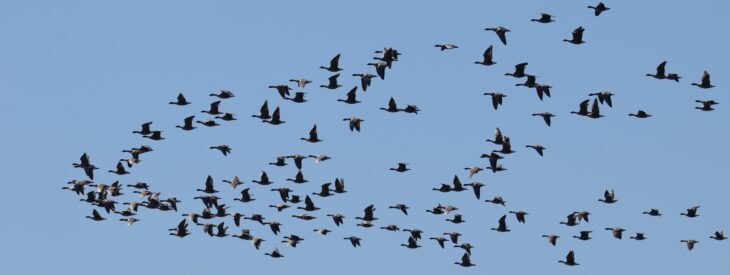
Another species on the move at the moment is the Pink-footed Goose (Anser brachyrhynchus). These birds do not breed here but can be seen in high numbers flying over Coigach and Assynt from their breeding grounds in Iceland and Greenland, heading to winter on our East Coast. A relatively small goose with a rounded head and short neck and, of course, pink legs and feet. Amazingly 90% of the world’s population (that’s nearly 400,000) of these geese winter in the UK! That’s a lot of birds to fly over us!
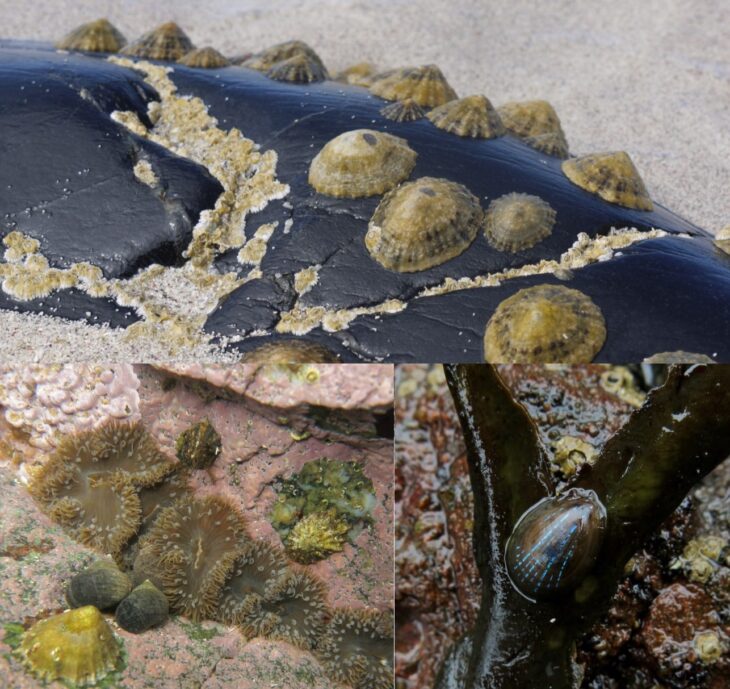
Limpets: often overlooked but another amazing creature found all around our shores. There are several different types found within Coigach and Assynt, the most common being unsurprisingly the Common Limpet (Patella vulgate). Other examples include the Blue-rayed Limpet (Helcion pellucidum), China Limpet (Patella ulyssiponensis), and occasionally Keyhole (Diodora graeca) and Slit Limpets (Emarginula fissure). Not only are they near impossible to move once they are settled on a rock; they also protect themselves by ‘mushrooming’ – the muscle foot will push the shell skywards, tilting side to side to dislodge predators and then stopping down to squash them if they are still attacking. Limpets can be found along all of our coastline, try looking for their ‘home scars’ (worn circles in the rock they grind away with their shell to fit in perfectly) where they return to after feeding on nearby microalgae and seaweed sporelings.
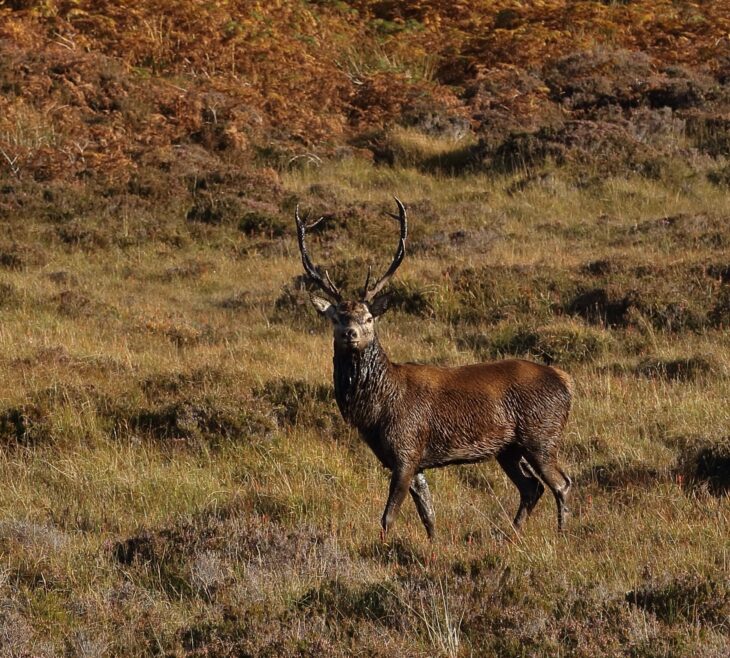
It’s that time of year when Red Deer (Cervus elaphus) begin the mating ritual known as the Rut. In Coigach and Assynt, Red Deer stags will gather in the hind’s home ranges to do battle, showing their strength and dominance to the other stags and hinds. A very spectacular thing to see but please keep in mind these are wild animals weighing up to 190kg with large sharp horns and can cover ground at an alarming rate. The stags are pumped full of testosterone leading to aggressive behaviour which can be misdirected to people if the following guidance is not taken (from the British Deer Society):
- Please keep your distance from rutting deer (100m plus)
- Use binoculars from a safe distance rather than getting closer
- Do not surround deer or intrude on displays. Stags may feel threatened and feel they must defend their hinds from you
- Please keep dogs at home or on a lead
- If a deer comes towards you or acts threatened: back away slowly until deer is satisfied. Do not run; you will be chased.
October is also the start of hind stalking season (October to February, Stags July to October) so please be aware of your surroundings when on the hills. Some great places to spot Red Deer would be Inchnadamph where hundreds gather every evening and along the roads to Achiltibuie.
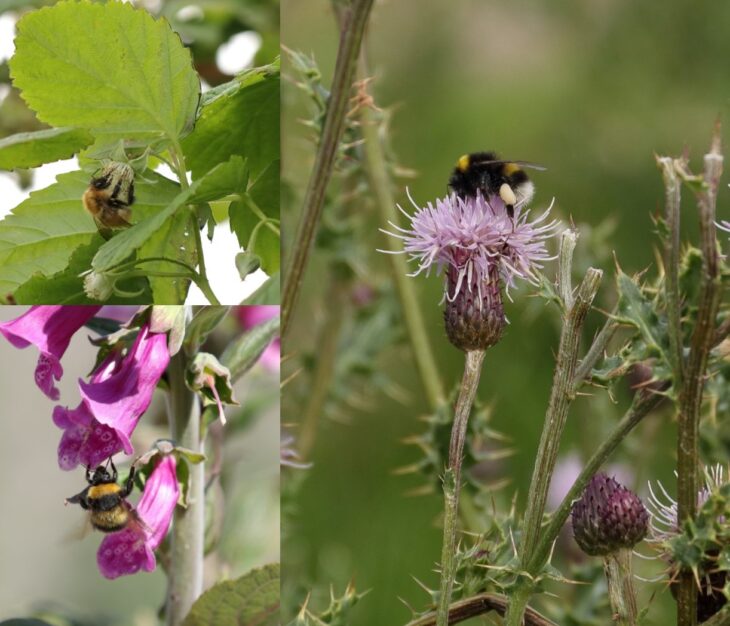
The last Bumblebees can be seen this month. The queens have been busy reproducing all year and are now dying off leaving the worker and male bees free to forage the last of the flowers. New queens will now be hibernating, ready for next season. The below species’ males and workers may be seen this month:
- White-Tailed Bumblebee (Bombus lucorum) – Most commonly seen Bumblebee in CALL. Males tend to have a yellow face, workers and queens don’t have a yellow band around the bottom of the thorax (like a belt).
- Garden bumblebee (Bombus hortorum) – a large bumblebee that is generally a low altitude species and widespread across the UK. Especially likes Foxgloves (Digitalis purpurea), Honeysuckle (Lonicera periclymenum), and Red Clover (Trifolium pratense) having a long tongue to enter the flowers easily.
- Red Tailed Bumblebee (Bombus lapidarius) – Another low altitude species that is being seen increasingly in CALL and north. Females are black with the distinctive red/orange tail. Workers are smaller versions of the queens; males have one or more yellow bands and a red/orange tail. Especially like the yellow Field Milk Thistle (Sonchus arvensis) and Asteraceae species (Daisy and Aster Family).
- Common Carder Bee (Bombus pascuorum) – One of the ‘ginger’ bees with workers and males still around in September. Widespread across the UK, loving Foxgloves, and Red Clover. It is often one of the last bees seen during the year. Hard to distinguish from the Moss Carder Bee (Bombus muscorum, also seen in CALL but scarcer), queen bees are easier to identify.
Anywhere with wildflowers, look for bees! Spots such as Achmelvich, Glencanisp and Achlochan give a range of habitats, helping you see more than one species in an area.
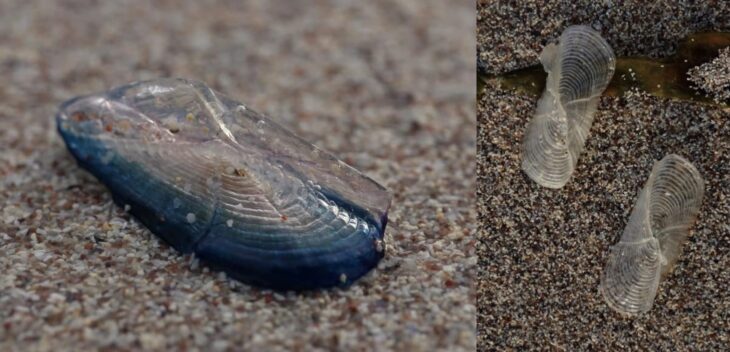
By-the-wind Sailors (Velella velella): an alien looking species that is mostly seen when washed up on shores during storms. In recent years, they have washed up in large numbers as a previous blog by the Assynt Field Club records: www.assyntwildlife.org.uk/2017/03/by-the-wind-sailor-on-the-north-west-coast/
They are a very odd-looking creature, related to the jellyfish. They are formed by an upside-down colony of floating polyps with stinging tentacles trailing behind an upright see-through sail. They come under a community class of pleustonic meaning they live at the boundary of air and water.
In September we start to see some iconic fungi species such as the Fly Agaric (Amanita muscaria). Its classic fairy tale looks, and red and white colouring is known by many although not all know its name. Through the CALL Digitisation project, the Assynt Field Club have compiled a list of species that have been spotted in recent years. Click here for the list: http://www.assyntwildlife.org.uk/2019/06/assynt-fungi-records/
Other Fungi to look out for include:
- Honey fungus species i.e. the Dark Honey Fungus (Armillaria ostoyae). A species that is uncommon in the south of the British Isles but common in Scotland. It is parasitic, meaning it ‘recycles’ dead trees. Again see Assynt Field Club’s account of this species for further information: http://www.assyntwildlife.org.uk/2018/09/exuberant-recycler-at-work/
- Waxcap species (Hygrocybe spp.). Examples of species found in Assynt are Parrot, Meadow, Honey and the Crimson. Often difficult to tell apart but they all have this cone shape.
- False Chanterelle (Hygrophoropsis aurantiaca) – look for these in Culag Woods
- Earths tongue (Glutinoglossum glutinosum) – A black tongue like fungi protruding from the ground
- Candle snuff (Xylaria hypoxylon) – white antler like fungi often growing on dead wood.
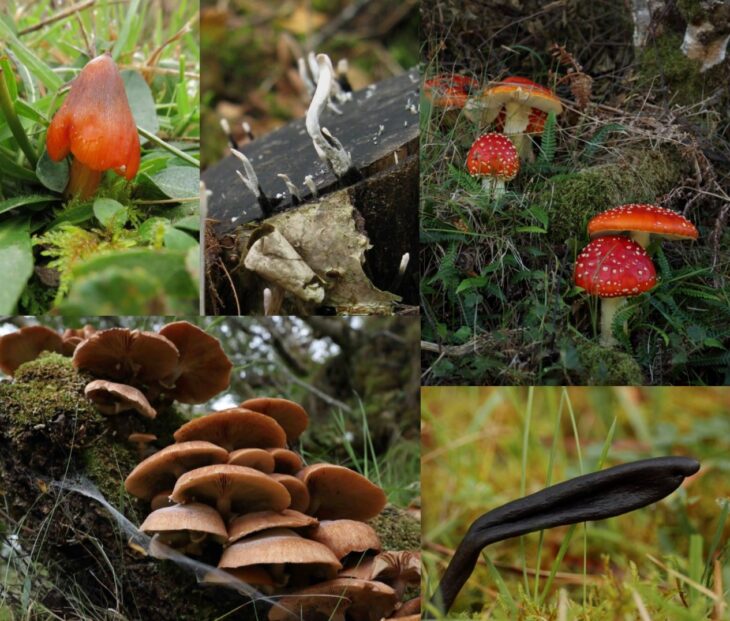
The coast around the CALL area holds the chance to see Skuas; a large seabird that is often known for dive bombing anything, or anyone, who gets close to their nests. There are four species that can be seen near our waters: The Great Skua, or Bonxie, (Stercorarius skua) and the less seen Arctic Skua (Stercorarius parasiticus) being the most likely with occasional sightings of Pomarine (Stercorarius pomarinus) and Long-tailed Skuas (Stercorarius longicaudus).
Bonxies, like all skuas, scavenge for food and have been recorded killing and eating Herring Gulls. Great Skuas generally arrive in April and are getting ready in September to fly to their wintering homes in Spain and Africa.
The Arctic Skua, which is noticeably smaller, is seen less often but breeds around Scotland’s coast. They have two central tail feathers up to 8cm long and a broad white flash on their underwing. They are often hard to tell apart from the similarly looking Pomarine Skua, which is occasionally seen from August to November on passage through the CALL area on its way from breeding in the Arctic to wintering in West Africa. It too has a long tail, but it is more spoon shaped. The Arctic Skua can often be seen chasing Terns fast and low along the water, trying to get them to drop their catch. They are also getting ready to migrate south for the winter. Handa Island (Scottish Wildlife Trust Reserve) is a great place to look for the Skua species (breeding here), although a little north of Assynt. Within Assynt they are spotted along the coasts whilst out looking for food.
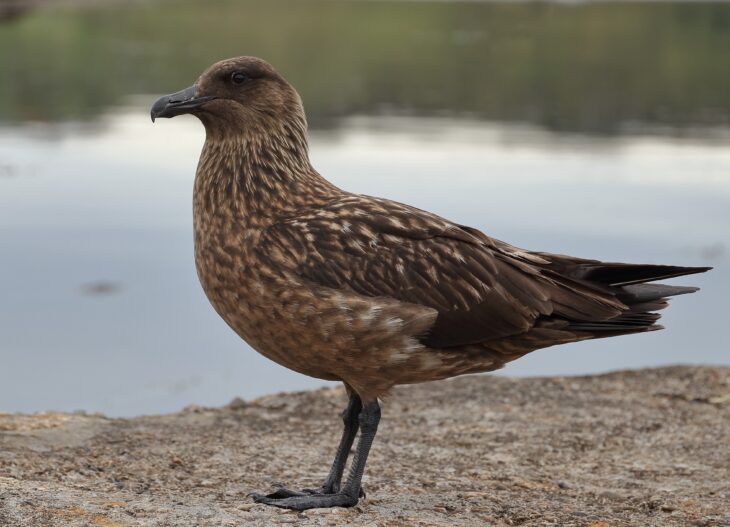
As we head towards Autumn, our wildflowers and trees are starting to provide fruits and nuts to reproduce themselves and, as an added bonus, feed our wildlife over the winter. Examples of species to make the most of soft berries such as Blackberries, Blueberries and Rose Hips include Pine Martens (Martes martes) and Foxes (Vulpes vulpes). A lot of wild foods for wildlife are also tasty to humans and foraging has become a household word in recent years. If you wish to forage in your local area, please research what to pick and how to eat it. It is also important to remember that the wildlife needs some too as well as some berries/nuts need to be left for reproduction: please forage responsibility and safely – one for you, one for the future and one for the wildlife. Best locations for finding these wild delights is along hedgerows or tree lines in sunny spots.
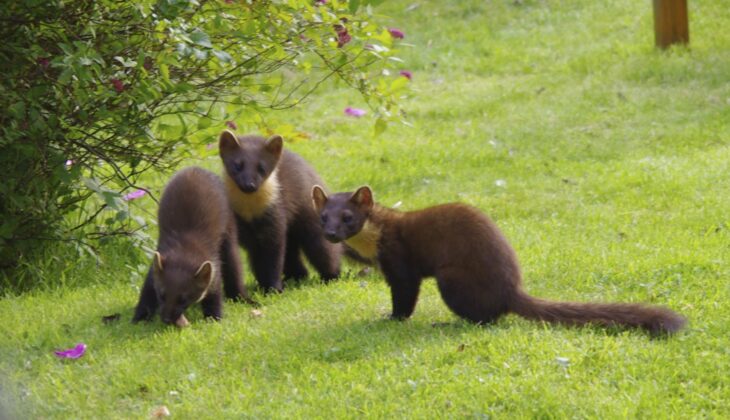
Another sign of Autumn is the trees starting to turn as they also prepare for winter. Birch (Betula spp.) and Oak (Quercus spp.) species seem to be the first indicators; some already having a golden glow to their leaves. “Why do leaves turn brown” I hear you say! Shortening daylight hours triggers the tree to produce less chlorophyll, the green substance that aids photosynthesis, and the leaves are ‘blocked off’ meaning sugars can no longer travel to the leaves. Slowly the chlorophyll and cells joining the leaf and the branch break down and the leaves will drop to the ground. The tree can then concentrate on keeping alive within the trunk in a sort of hibernation state over the winter, waiting to break out new leaves in the Spring.
Enjoy being out and about in Coigach and Assynt this month and as always please enjoy our wildlife and scenery responsibly.
